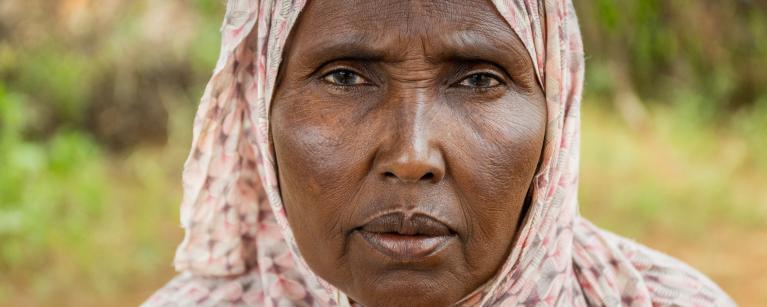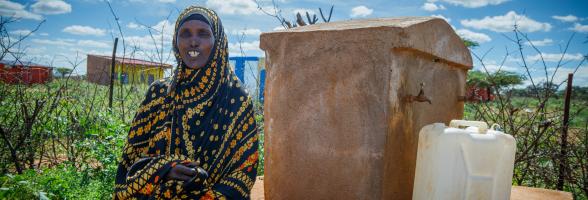Under a tree near her home, Shamis Ali Dahir sits on a woven mat with her daughter Nasri Abdulahi. A gentle morning breeze blows across their courtyard, and It’s cool in the shade. Next to Dahir is a crutch, which she needs to move around since she recently broke her leg.
They talk about the weather, and how dry it has been in recent years here in their town, Garowo, in the eastern Ethiopia Somali Region. “For the last three years we have tried to grow crops. Every year, we try to plant, but it fails,” Dahir, who is 40 and has eight children, says. “Whatever we put in the ground fails, for the last three years.”
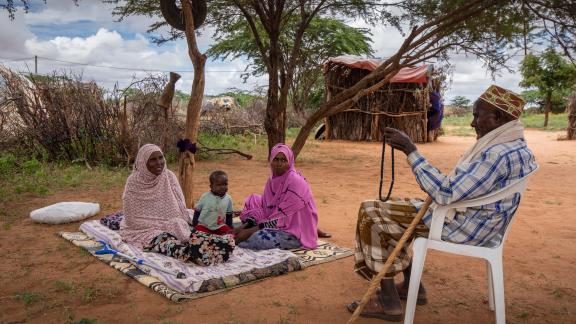
Shamis Ali Dahir, left, sits with her family at their home in Garowo, Somali Region, Ethiopia. Photo credit: Petterik Wiggers / Oxfam
Her 20-year-old daughter Abdulahi, who works on the family farm, says that last year Oxfam gave the family some sorghum, maize, bean, and onion seeds, which they planted and were cultivating in hopes of growing some food they could eat and sell. It was part of an initiative led by Oxfam to provide seeds and tools to 450 families in the Somali Region.
When the 2022 seasonal rains failed to materialize, Abdulahi says “I was demoralized. I was so sad when I realized it was all dead.”
East Africa Hunger Crisis
East Africa is in the grips of a sustained hunger crisis. The historic five-season drought that started in 2021 combined with conflict, and volatile food prices have pushed communities to the brink with more than 31 million people facing crisis levels of food insecurity in Kenya, Ethiopia, Somalia, and South Sudan.
In addition to conflict, South Sudan’s crisis is due to heavy rains that have flooded out homes and agricultural fields. And in 2023, conflict in Sudan has brought tens of thousands of refugees into South Sudan seeking safety.
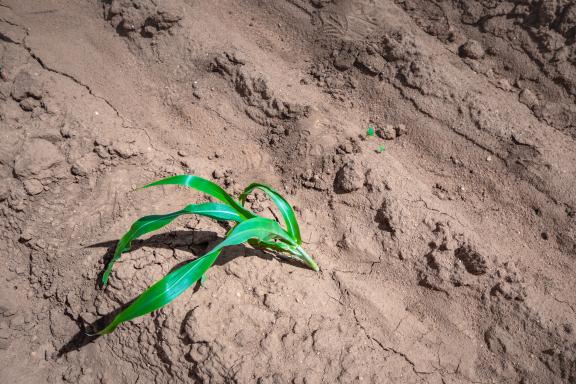
East Africa Hunger Crisis
- 31.5 million people are facing crisis levels of food insecurity in South Sudan, Kenya, Ethiopia, and Somalia
- 13.2 million livestock have died across East Africa due to climate-induced drought, and lack of water and pasture. Previous experience shows it takes five years for a pastoralist family to rebuild its herd.
- In addition to enduring the effects of climate change, the war in Ukraine and inflation are increasing prices for food and fuel, and higher prices for agricultural inputs like seeds and fertilizer are making it difficult for farmers in East Africa to plant crops.
What Oxfam is doing to help people in East Africa
Oxfam is responding to the East Africa hunger crisis by partnering with local organizations to reach more than two million people in Kenya, Ethiopia, Somalia, and South Sudan. Key elements of assistance include:
- Distributing cash to help families buy food and meet other immediate needs
- Providing clean water, latrines, and hygiene items like soap, and promoting good hygiene and other public health measures to help communities avoid deadly diseases
- Animal feed and veterinary assistance to help animals survive the drought
- Food
- Seeds, tools, and other equipment to help farmers plant crops and grow their own food again
- Raising awareness of women’s rights and measures communities can take to ensure women and girls are safe, and how survivors of violence can get help
- Distributing Dignity Kits (that include menstrual products) to women and girls
- Training to help community members resolve conflicts and build peace between clans
Oxfam is also supporting efforts by organizations in East Africa that are advocating for their governments and others to respond to the immediate crisis with humanitarian assistance, while also investing in programs and services that fight inequality and help vulnerable people improve their lives over the long term and reduce their vulnerability to climate change.
Assisting displaced people in Ethiopia
Across the Somali Region in southern Ethiopia, hundreds of thousands of people who have been displaced by drought and conflict are living in camps, depending on humanitarian assistance from the United Nations, non-governmental groups like Oxfam, and the government.
In the southern Jarar district, Shugri Mahdi, a 39-year-old farmer, and his family are struggling with food aid and hoping the drought will end soon. They live in a community called Laas Galol and have been here for five years since they fled communal violence in the nearby Oromia Region.
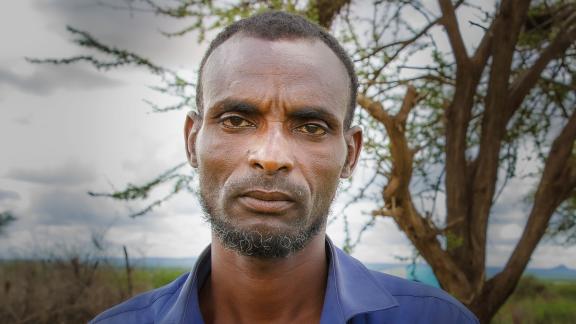
Shugri Mahdi Aden, 39, is one of program participants from his village, Laas Galol. Photo credit: Petterik Wiggers / Oxfam
Mahdi's family, including his two wives, nine children and his mother, like many other ethnic Somali people, came to the Somali Region to seek safety, bringing whatever they could carry and their livestock. Mahdi was able to bring 30 goats and 15 cows. He says all but two goats have died in the ensuing drought.
More than 4.5 million livestock are estimated* to have died due to a lack of pasture and water in the Oromia and Somali regions since 2021 due to the drought, while many more are in poor condition.
It's a difficult life for people displaced by conflict and drought in the Somali Region. "Look," Mahdi says, "our house is not made of strong materials. When it rains, it cannot withhold the water. The children are shivering. We don't have anything. The only thing we have now is what Oxfam and [the government] gave us."
At various times, Mahdi says Oxfam has provided his family with
- Cash: Altogether 13,500 Ethiopian birr, or about $245 in three installments of roughly $81
- Food: two 45-kilo bags of flour (90-kg total), salt, and cooking oil.
- Dignity Kits containing soap, women’s underwear, menstrual products, and other hygiene items
- Jerry cans for storing water, wash basins for washing clothes
“When we ran out of money, the food was important,” Mahdi says. “You can spend cash quickly but the food lasted more than a month.” He says they used the flour to make traditional Somali pancakes for breakfast.
Due to budget cuts, Oxfam has not provided any of this sort of assistance for a few months. And the food aid provided by the government is not predictable either. Some months they get food, sometimes they wait three months.
On this day, one of Mahdi’s wives Fathiya Ali Abdulahi, 28, is giving her children a meal of boiled wheat meal. They gather in a small structure that serves as their kitchen, where their oldest son (12) is tending the fire and a pot of food. The children eat the wheat out of metal bowls, and share a glass of tea.
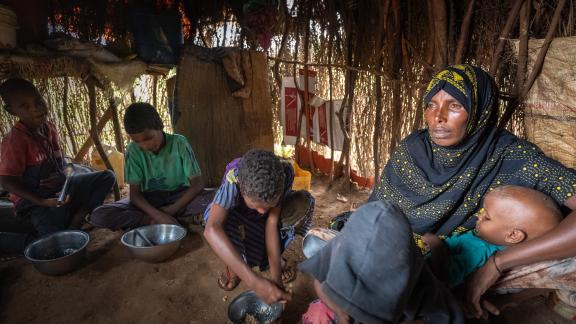
Fathiya Ali Abdulahi prepares and serves lunch to her children at their home in the Laas Galol camp for displaced people, Jarar District, Somali Region. Photo Credit: Petterik Wiggers / Oxfam
Outside, a dark cloud sends down a few rain drops. Mahdi says the intermittent rains are a promising sign. “The better rain here is helping.”
It makes him think that perhaps he could get access to land and begin farming as a way out of his current problems, but is not sure if it is possible. “I want to change my life, and I want to change the life of my family. Since we are getting rain here, I want to get some land and plant sorghum.”
In the meantime, he makes sure his children can attend a nearby school. “I want my children to have a better future than I had, and education is the key,” Mahdi says.
Overcoming hunger and disease
In the northwestern section of the Somali Region lies the community of Quologi, so named when it was the site of an agricultural college. Among the rocky hillsides is a camp for displaced people now hosting 101,000 in more than 60,000 households. Many, like Hees Mahamud Tahir, came here six years ago to escape ethnic violence in the neighboring Oromia Region. The middle-aged mother of five children says most of the displaced people now in Qulogi are pastoralists and farmers, and business people like her. She ran a shop where she sold flour, rice, biscuits, and juice.
Now, like most of the other people in Quologi, Tahir says she and her family are living on rations from the World Food Programme. Every three months she says the WFP gives them 90 kilos of rice, two liters of oil, and five kilos of lentils. It’s not enough for a family of six, so lack of food is a constant worry. And in recent years, the sustained drought is putting even more pressure on the food supply, as more pastoralist families are moving to Qulogi.
“We are trying to share all the resources,” Tahir explains.
More and more people in Qulogi also strains the sanitation facilities, Tahir says. “We don’t have enough toilets and there is a lot of waiting, sometimes all day, to use a toilet. Sometimes 30 to 40 people are waiting, and if they don’t have the patience they just go [outside].”
Open defecation, lack of soap, and other challenges raise the risk of disease in Quologi, Tahir says. She is a community health volunteer (CHV), one of six in Qulogi trained by Oxfam to promote good hygiene, proper use of latrines, and management of solid waste – all important for avoiding diseases.
“We show people how to wash hands with soap after using the toilet, wash your hands before feeding your children, and to clean their jerry cans,” Tahir says. “We raise awareness about the need for good hygiene and a clean environment.”
One of her fellow community health volunteers is Hawo Are, [age], a mother of a two-year-old son. She is also raising two nieces living with her at the camp. Are explains that in a camp for displaced people where men set the priorities for humanitarian assistance, the focus is mostly on food. “When there’s a shortage of food, it’s hard to focus on women’s health problems,” Are says.
That’s why Oxfam worked with the women CHVs to distribute 6,100 Dignity Kits, which contain menstrual products, underwear, bath soap, and laundry soap.
Are says it was a struggle just to distribute the Dignity Kits in a public place with men around. “At first women were scared to take them at all.”
She credits the awareness-raising programs she and her Oxfam-trained colleagues have undertaken in Qulogi. Now, Are says. “They are more aware and are willing to take them.”
“Previously, when women were menstruating, they stayed at home, and girls did not go to school,” Are says. “They missed classes, but now they are not missing school.”
Rains bring optimism
In April and May 2023, there’s been some rain in some areas of the Somali Region. Although the occasional field may look green to some, the pastoralist families that rely on livestock for their livelihood may not be optimistic. These Somali families, who have survived for centuries raising and herding livestock across East Africa, face the biggest challenges to recover from drought.
“There's rain now, but that will not support the families who have already lost their animals because of the drought,” says Muhumed Ali Yusuf, Oxfam’s area manager in the Somali Region. He says Oxfam is working hard to improve water resources like wells, and distribute animal feed and veterinary assistance for families with a few breeding animals they are desperately trying to keep alive. He says it will help families save their remaining animals so they can rebuild their herd.
For farmers, a bit of rain may be an opportunity – if they can find the seeds and other inputs they need to grow a crop.
In Garawo, Shamis Ali Dahir and her daughter planted their sorghum field earlier this spring after borrowing some seeds from cousins living in another part of the Somali Region. This is a common way that families survive tough times in the Somali Region. “Families help one another when they are in need,” Dahir says simply.
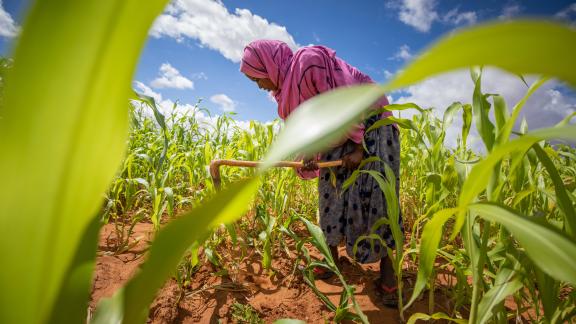
At the sorghum field of Shamis Ali Dahir in Garowo, Jarar District, Somali Region, Ethiopia: Shamis Ali Dahir’s daughter Nasri Hamdi Abdulahi, 20, is checking the field and weeding. Photo credit: Petterik Wiggers / Oxfam
After that, they scraped together 3,200 Birr (about US$58) to hire a neighbor with a tractor to prepare the half-hectare field.
Nasri Abdulahi, Dahir’s daughter, does a quick check on the family sorghum field. She moves among the rows of plants with a long-handled hoe, pulling out a few weeds here and there, and generally looking things over, her bright pink hijab contrasting sharply with the plants and the cloudy sky.
In some areas, the plants are up to her knee, and a sickly, pale yellow. But in others, they plants are over her head, and although still mostly immature a few stalks are starting to produce grains.Having seen so many harvests fail in recent years, Abdulahi is aware that they will need more rain before a harvest in September. She is careful to consider how she will describe the field on this day to her mother, who is injured and can’t check the plants herself.
“I will tell her that our farm this year looks very good, and that if it keeps raining the plants will mature, I am sure,” she says confidently.
“I am very hopeful.”
